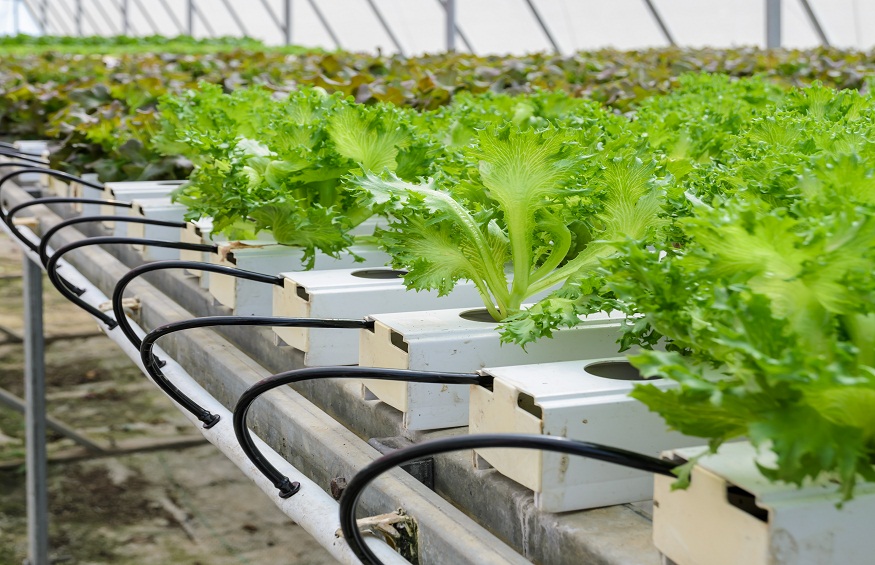Hydroponics is a soilless agriculture technique in which plants use water solvent having minerals and nutrients. Roots are either given support with a physical medium like gravel or placed into the nutrient solution. Unlike plants in the soil, hydroponics plants receive all nutrients from water solution. Then they undergo photosynthesis. The familiar sources of nutrients are fish excrement, duck manure, or chemical fertilizers. This system uses up to 90 percent less water and yields better. With the recent rising awareness of sustainable farming, Hydroponics In India and other countries with arid climate is gaining wide popularity. It can be an efficient tool to cope with increasing food insecurity due to India’s dwindling availability of fertile soil or clean and surplus water.
Indian agriculturalists are fighting a drastic reduction in the availability of locally grown food for India’s large population; with its economic feasibility, hydroponics in India seems the best solution. Immense potential and opportunities and come with its own set of challenges. Let’s look at the importance and advantages and disadvantages and types of crops suitable for India’s hydroponics.
Opportunities Of Hydroponics In India
- There is a huge market to capture due to population growth.
- The potential market for hydroponics in India is retail and hotel, fast food chains, railway catering, foreign food service companies, defense, etc.
- Favorable labor cost
- Suitable climatic conditions
- Intelligent Human capital
Importance Of Hydroponics In India
The average national production of vegetables in India is 17 tons/h, which is significantly less than developing countries with an average of 40 tons/ha. Horticultural crops occupy: From a recent study of 2014, Only 17% of India’s agricultural land and only 30,000 hectares (ha) have covered cultivation (polyhouse ).
The current food market in India is estimated to be $78B. India imports a considerable amount of vegetables round the year to fulfill its national requirement at a lower price. For example, when exported, Cherry tomatoes cost around 1000/kg. If we can produce it in India it will cost only 22/kg. In India, there is a continuous rise in attraction for exotic vegetables like golden beetroots, Caribbean peppers, thirteen varieties of lettuce, asparagus, etc. Hydroponics India can bridge the gap to produce both indigenous and exotic vegetables.
Crops To Grow With Hydroponics In India
Hydroponic in India is like the need to produce high-quality pesticide-free vegetables, especially for urban residents. You can find various crops; the following list provides you the common vegetable suitable for Indian conditions.
Tomatoes
Tomatoes need a pH level of 5.5-6.5 and require sufficient sunlight. A wick system and flow systems are best for both traditional and cherry tomatoes.
Lettuce, Radish & Spinach
Maintaining a cool temperature and PH6-7 is essential to produce winter crops. Aeroponics is best for lettuce, radish, Spinach, and other leafy vegetables, as they have shallow roots, short above ground height. With the help of hydroponics in India, We can produce cold-weather crops like lettuce. Radish & Spinach throughout the year that has high demand in the Indian market.
Strawberries
Strawberries are the most popular crop grown with hydroponic production in India. It requires a warm temperature and pH level of 5.5-6 for the year-long crop. For plants with deep roots and need support, either Wick systems or Ebb and Flow systems are best.
Herbs
Herbs are an inseparable part of Indian cuisine since immemorial time. You can use hydroponics in India to grow herbs like basil, chives, cilantro, dill, mint, oregano, parsley, rosemary, and thyme. The moist environment, lots of light, warm temperature, and pH level 5.5-6.5 are the perfect conditions for Basil. The Drip system works best for Basil. All hydroponic systems are favorable to grow herbs, where nutrient level, pH level, and temperature need to be optimized as per the plant’s requirement.
Hydroponics In India
Hydroponics in India is setting its roots all across the country. It is a lucrative business opportunity as well as eco friendly for dealing with the vagaries of global warming. It is becoming synonymous with urban farming, where land is diminishing continuously. Hydroponics in India can make it possible to grow almost all kinds of vegetables to meet the domestic need and supply international markets.




